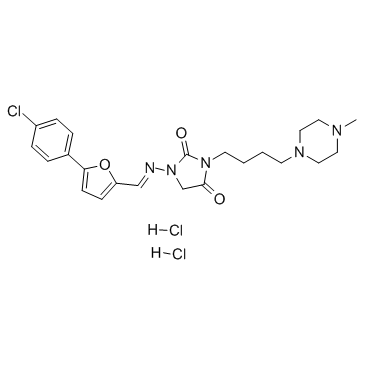Azimilide Dihydrochloride (Synonyms: NE 10064) |
| Catalog No.GC35453 |
Le dichlorhydrate d'azimilide (NE-10064) est un composé antiarythmique de classe III, inhibe I(Ks) et I(Kr) dans les myocytes cardiaques de cobaye et les canaux I(Ks) (minK) exprimés dans les ovocytes de Xenopus.
Products are for research use only. Not for human use. We do not sell to patients.

Cas No.: 149888-94-8
Sample solution is provided at 25 µL, 10mM.
Azimilide Dihydrochloride (NE-10064 Dihydrochloride) is a class III antiarrhythmic compound, inhibits I(Ks) and I(Kr) in guinea-pig cardiac myocytes and I(Ks) (minK) channels expressed in Xenopus oocytes.IC50 value:Target: in vitro: Azimilide blocked HERG channels at 0.1 and 1 Hz with IC50s of 1.4 microM and 5.2 microM respectively. Azimilide blockade of HERG channels expressed in Xenopus oocytes and I(Kr) in mouse AT-1 cells was decreased under conditions of high [K+]e, whereas block of slowly activating I(Ks) channels was not affected by changes in [K+]e [1]. Azimilide suppressed the following currents (Kd in parenthesis): IKr ( or = 50 microM at +50 and -140 mV, respectively). Azimilide blocked IKr, IKs, and INa in a use-dependent manner. Furthermore, azimilide reduced a slowly inactivating component of Na current that might be important for maintaining the action potential plateau in canine ventricular myocytes [2]. In guinea pig ventricular myocytes, Azimilide (0.3-3 microM) significantly prolonged action potential duration (APD) at 1 Hz. At 3 Hz, Azimilide (0.3-1 microM) increased APD only slightly, and at 10 microM decreased APD and the plateau potential. Azimilide potently blocked the rapidly activating component of the delayed rectifier, IKr (IC50 0.4 microM), and inhibited IKs (IC50 3 microM) with nearly 10-fold less potency [3].in vivo: Azimilide (10 mg/kg intravenously, i.v.) reduced (p < 0.05) the incidence (8 of 12) of PES-induced ventricular tachycardia (VT). The cycle length of induced VT was not prolonged by Azimilide (0.245 +/- 0.046 s predrug vs. 0.301 +/- 0.060 s postdrug). Azimilide increased ventricular effective refractory period (VERP 166 +/- 5 ms predrug vs. 194 +/- 13 ms postdrug, p = 0.013), prolonged QTc interval (310 +/- 12 ms predrug vs. 350 +/- 16 ms postdrug, p = 0.004) and prolonged the effective refractory period (ERP) of noninfarcted myocardium (p = 0.045) [4].
[1]. Busch AE, et al. Blockade of HERG channels by the class III antiarrhythmic azimilide: mode of action. Br J Pharmacol. 1998 Jan;123(1):23-30. [2]. Yao JA, et al. Azimilide (NE-10064) can prolong or shorten the action potential duration in canine ventricular myocytes: dependence on blockade of K, Ca, and Na channels. J Cardiovasc Electrophysiol. 1997 Feb;8(2):184-98. [3]. Fermini B, et al. Use-dependent effects of the class III antiarrhythmic agent NE-10064 (azimilide) on cardiac repolarization: block of delayed rectifier potassium and L-type calcium currents. J Cardiovasc Pharmacol. 1995 Aug;26(2):259-71. [4]. Black SC, et al. Protection against programmed electrical stimulation-induced ventricular tachycardia and sudden cardiac death by NE-10064, a class III antiarrhythmic drug. J Cardiovasc Pharmacol. 1993 Dec;22(6):810-8.
Average Rating: 5 (Based on Reviews and 35 reference(s) in Google Scholar.)
GLPBIO products are for RESEARCH USE ONLY. Please make sure your review or question is research based.
Required fields are marked with *




















